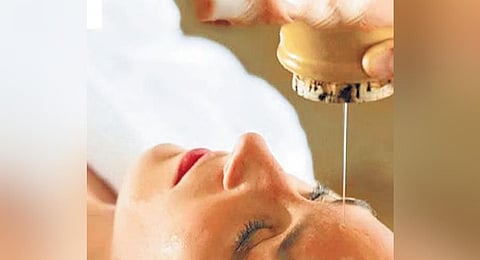

Headaches are a common issue, and when accompanied by symptoms such as severe intolerance to sound, vomiting sensation and throbbing pain, it falls under the category of migraine. Instead of delving into contemporary pathophysiology, let’s explore Ayurvedic insights into the condition and preventive measures.
The spectrum of shirashoola: Ayurveda categorises shirashoola—‘shiras’ means head, and ‘shoola’ refers to ache—into various types based on symptoms, pathophysiology and clinical presentation, such as Vatika shirashoola, Paithika shirasoola, Kaphaja shirashoola, Ardhawa bhedaka, Surya vartha, etc. The severity of headaches varies with the diurnal rhythm, with some peaking in the afternoon (pitta dominance), or after sunset (kapha and vata dominance). Different types of pain, like dull, throbbing, or burning, must be distinguished from other conditions like trigeminal neuralgia and hypertensive headaches.
Relation between headaches and gut: Ayurveda emphasises a direct connection between the head (shiras) and the alimentary tract (koshtam). Chronic constipation can manifest as shiroruk (headache). Therefore, maintaining a clear gut is the primary approach to managing headaches. Proper digestion and assimilation, driven by the agni (metabolic fire) in the koshta, play a crucial role. Pitta dominance can lead to acidity-triggered headaches, while indigestion may cause a dull headache with head heaviness. Stress often precedes headaches, and continuous exposure to a stressful environment or emotional distress can contribute to their occurrence.
What to and what not to do: Minimise exposure to light and sound as the episode begins. If there’s a vomiting tendency, inducing vomiting by tickling the upper palate can provide relief. Applying dry heat, such as a cloth heated on a tawa, may alleviate pain in some cases. Skipping meals, late-night dinners, and excessive sun exposure followed by a head bath can trigger migraines. Timely intake of fluid-rich foods is recommended, while dry, stale, spicy and frozen foods should be avoided.
Treatment possibilities: Internal medications fall under shaman chikitsa, while shodana chikitsa aims to purify the body for chronic severe cases. Various internal medications, such as kashyams like pathykshadhtyadi and chiruviwaditabs like shirashoola vajrarasam, are prescribed. Procedures like virechana, vasthi, shirodhara, takradhara and nasyam (nasal application of medicine) are practiced with different materials based on individual cases.
How to prevent: Individuals prone to continuous migraine attacks can undergo yearly panchakarma to maintain overall system health. Prioritising gut health through good sleep, dietary modifications, practicing meditation, pranayama, regular exercise, hydration, and exposure to natural sunlight and wind can contribute to a healthier lifestyle.
By embracing Ayurvedic principles, we can aim to alleviate migraines and lead happier, headache-free lives.
The author is a Professor at the Department of Panchakarma, Ashtamgam Ayurveda Medical College, Kerala